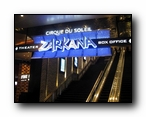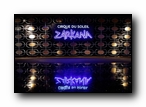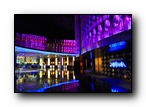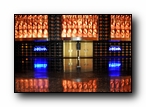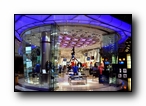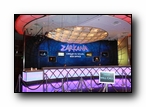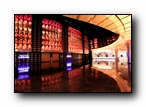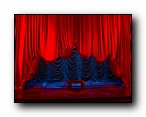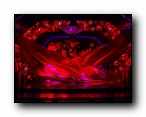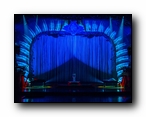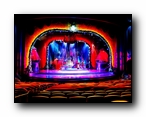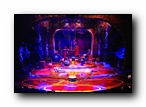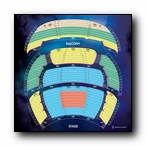
![]()
[ You are here: Grand Chapiteau | Creations | Zarkana | Scénographie ]
Création
Expérience
RéserveRetiré
Odyssey
As written and directed by François Girard (whose credits include the 1998 film The Red Violin and the Keira Knightley starrer Silk (2007), Zarkana is an acrobatic rock opera that blends circus arts with the surreal to create a world where physical virtuosity rubs shoulders with the strange. The story follows Zark, a magician who has lost his powers and the love of his life - in an abandoned theatre populated by a motley collection of off-the-wall characters and incomparable acrobats. He runs into the Mutants, four sirens as sinister as they are fabulous, who are determined to divert him from his quest. Zarkana is a visual vortex set in a slightly twisted musical and acrobatic fantasy universe where, little by little, chaos and craziness give way to festivity and love regained. The diverse cast of more than 75 international artists transports the audience into a fantastical and suspenseful world, blurring the boundaries between the real and imaginary. The name Zarkana is a fusion of the words 'bizarre' and 'arcana.' The twisted fictional world of Zarkana is an elusive destination that is fantastic yet bizarre. The name refers to the irresistibly odd and delightfully strange aura of this place and its inhabitants. Taking this to heart, the production's design team has provided a series of looks and sounds designed to disorient the audience even as the cast is put through its heart-pounding paces.
Stéphane Roy's design for Zarkana is an attention grabber from the minute you enter the auditorium. It represents an abandoned theatre, and is meant to exist as a character in its own right. Roy, who used various curtains, from Austrian, French, Kabuki, and Venetian, to punctuate the performance and set the various scenes, notes everything with Zarkana was large-scale. "The idea was that the theatre had been abandoned for 75 years," he explains. "We wanted to express the idea of timelessness, we have been there before, we are there now, and will be there again. Everything is mystical, full of memories." With that idea in mind, there are not a lot of set changes, but rather one set that evolves throughout the entire show. Thanks to projection technology, the walls of the theatre are alive with movement and color. The main set elements consist of three hand-sculpted arches, representing three of the four mutants who try to divert Zark from his seek-and-find missions.
Roy says that he approached this historic venue with care. "It's like a cathedral," he notes. "You don't want to kill it, but you have to make it your own. I quickly proposed continuing the room's many arches in the set design." The use of arches was also intended to forge a feeling of intimacy in New York's biggest theatre: "The scale of third arch is basically the scale of a Broadway stage; it's a scale that people can relate to; it gives them a sense of perspective." The main set elements consist of three sweeping arches – all sculpted by hand – representing the three MUTANTS. The first arch represents KUNDALINI, the Snake Lady, whose world is populated by dozens of slithering snakes. It's the largest of the three arches and is decorated with more than 150ft of hand painted resin "snakes". (These were created using Styrofoam s culptures as molds into which was poured a liquid resin.) The second arch, which also serves as a video screen, harbors MANDRAGORA, a plant-like creature that comes to life with "arms" extending out like scissors nearly 100 feet. The second arch, which is also a video screen, harbors Mandragora, a plant-like creature who comes to life with arms extending out like scissors across nearly 100'. The third arch represents the Pickled Lady, a video-based creature, with six arms, who lives in a pickle jar. The third represents TARANTULA, the spider woman in her web. From the audience's point of view, the divisions between live action, stage effects, lighting and projections are seamless. "The first arch is opaque," says Roy. "It's almost as if it is part of the venue. The second arch is constructed with LEDs behind an opera scrim, supplied by 3M, which has been painted. The third arch is translucent. In other words, the frame is solid. The closer the set comes to the audience, the more real it is; the closer you get to the middle, the more it becomes like a vortex." Another major scenic elements in Zarkana is the 90-foot x 40-foot Panasonic LED wall that is installed upstage. "We actually thought about not using the LED wall, and not using any electronic media," Roy explains. Instead he had designed a set based on Gustav Klimt golden tiles to tie into the gold of the theatre. "The room and its art nouveau texture were the priority, but then we thought we could use the LED wall as a breathing element, so we finally added the video," the designer notes: Then we went wild. "We had the tools, we might as well use them." Not to mention that Zarkana's director, François Girard, comes from the film world and was comfortable with the large, cinematic tableaux created for the show. Roy also drew on Radio City's decorative style. "Going back to the theatre's roots, I looked into the Art Deco and Art Nouveau styles. Deco is more phallic and Nouveau is more fallopian." He adds that the arches, with their baroque details, are also inspired by the Spanish architect Antoni Gaudí, whose whimsical structures are one of the glories of the city of Barcelona. "This gives it a sensual feeling, as if the walls are talking. The idea of ghosts in the walls is very Art Nouveau." At the end of the show, when darkness is dispelled and everything is bright and shiny, he says, "The staircase that comes in is very Art Deco. It's as if it's the first day in the history of Radio City Music Hall." In addition, there are nods to New York itself in the design. "It's not so evident," says Roy, "but, upstage at the opening of the show, you see Zark appearing in a hole; the shape of which is the shape of Manhattan Island, as seen from the sky. There's also a full moon, which represents Radio City Music Hall." Some of the most startling scenic effects take place upstage. One is the "clown curtain;" an Austrian comes in, covered with the production's clowns, sporting umbrellas and hanging upside down. Speaking about it, Roy says, "We always begin with a blank page at Cirque du Soleil. Someone made a joke that it would be nice to have two clowns hanging upside down, and somebody else asked, 'Can we hang some guys?' - and it became a project." During the hand-balancing act, a performer, working downstage, is backed by a series of vertical fabrics from which the clowns dangle in various positions. Another setting, which amused many in the audience during this past summer of Spider-Man, features an aerial act stage in front of a giant spider's web, with a lady arachnid belting a power ballad as bodies fly through the air. Interestingly, given its elaborate nature, the production was designed and constructed with touring in mind. "We're not in Las Vegas, where we can screw ourselves into the walls of the theatre," says Roy. "We're working inside a historical monument." Therefore, he says, "We built our own proscenium theatre; it consist of four legs that are 90' high and don't touch the theatre's interior. It's like a Rolling Stones tour; we arrived in Radio City Music Hall with our own trussing, which holds our lighting and automation. Only on the far upstage area are we using some of the theatre flies." The needs of the show dictated a number of other unusual details, as well. Instead of steel cables, the cradle stations used in the flying trapeze act rely on "hanger tubes" for their rigidity. The structure of the high-wire number installed on the floor of the theatre's orchestra pit is freestanding, without any anchor. The 60-foot-by-33-foot curtain of ropes that Zark conjures up suddenly drops to the stage like a Kabuki curtain. And the two eagle's-head bandstands that house the musicians on either side of the stage are 28-foot tall and weigh more than 9,000 lbs each. Stage One, in York (UK) built the skeleton for the set, the acrobatic trusses, and the stage floor, while the skin and painted fabrics were al created in Montreal by Dominique Gaucher.
Making the set come alive are the projections created by Raymond St. Jean, the production's image content designer. Himself a film director, he also designed content for ZAIA. "The video content of the show is highly complex and plays an integral role in the storytelling process," he notes. "Projections have scenic value. A number of the images projected onto the arches above the stage are interactive and react to what is happening on stage. My goal was to bring maximum credibility to this strange parallel world awakened by the wizard Zark."
For example, during the high-wire act, the video arch is gradually invaded by writhing snakes that pay close attention to and react to the artists' movements. Flames shooting up from the stage are reflected on the undulating forms of the snakes. St. Jean, who worked on the show for nearly three years, says CDS' lengthy development is crucial to the achievement of the final effect. Girard, he says, "has done a lot of film and is aware of the needs and possibilities of film and video. We started with his concept of the show, which was drawn crudely on a storyboard; the visual ideas evolved around the basic ideas of each act." He cites as an example the Wheel of Death: "At first, it was supposed to be a bicycle number," the designer recalls. "We started with images of gears in the background, all of it synchronized with the action on stage. Then the bike idea went away and the Wheel of Death came in. It became a time machine, then an electrical machine - but always we had the idea of something mechanical. The visual concept went from gears to a clock to a big machine." The video is controlled by the wheel of death itself. "There is live interaction with the video - as the wheel turns it makes the video go at the same speed... it is not pre-programmed. There is a decoder in the middle of the wheel, if it stops, the [video] stops, when the wheel goes forward it goes forward, etc." During the ‘hand balancing' acrobatic act, the backdrop is a curtain of ropes, with a projection of the performer's silhouette. "There is a camera filming him, done live, and we project a filmy silhouette onto the rope curtains and LED wall. It is a simple but beautiful moment," adds St-Jean. In the high wire act, the idea was to how to use the video to direct the audience to the performer and not distract. "There are snakes coming in to frame the act and look at the act, not take away the audience attention. The snakes react to what's happening on stage... what's great is the technology that works so seamlessly, not to make the effects too obvious, but very organic." Noting Roy's idea of placing LEDs into the arch behind a painted scrim, he says, "The ideas are aesthetically intertwined, making video as close a part of the set as possible. We worked together very closely." Commenting on Radio City's LED wall, he adds, "It would have been foolish not to use it. It's 90' by 40', so we began by taking that into account; after that, we added the 10mm LEDs in the arch." There are more than three million pixels in the upstage wall. The images were developed by the graphic motion company Fly Studio. "We did a lot of green-screen shooting for the images," says St. Jean. Alexis Laurence, who works with St. Jean as a multimedia project manager, notes that the upstage Radio City wall was custom-made for the theatre by Panasonic. The LEDs in the arches were a custom project from a manufacturer in China, working with Solotech, the Montréal-based gear supplier. He adds that 118 full panels were required for the arch. In addition, three 20K projectors from Christie Digital, attached to Zap Technologies yokes, are responsible for the show's relatively few moments of front projection. One reason for these is the sand-painting act, in which a young woman, standing downstage, manipulates colored sand, creating new images in a matter of seconds; her handiwork is shown on a medallion screen on the proscenium. In all cases, images are delivered by Photon media servers from VYV, a Montréal-based firm. Cueing is handled by a Vizio controller. "We asked for a big custom MIDI interface," says Laurence, who adds that each act has its own page of cues. St. Jean notes that he had to be careful when designing the imagery. "There's always a concern that the LED wall might upstage a number. At one point, I added images of fireflies, and they were stealing attention from the performers. We dimmed them down a bit. Everything I do is meant to draw attention to the act." He cites a moment, late in the show, when he covers the set with images of eyeballs floating in water. The idea, he says, is "to have the eyes focused on the act, to draw the audience's attention to it. It's the same thing with the hand-balancing act; when we started with it, we worried about losing the performers in this big hall. [Thus the non-video tableau of clowns clutching the vertical fabrics.] Always, we had in mind what we could do to make an act seem bigger."
In lighting Zarkana's numerous acrobatic acts, Lortie's rig of primarily moving lights and LEDs gave him a leg up during rehearsals, as he was also to work straight through without stopping to focus conventional fixtures. "I like to build images for the director, and then, through subtraction, take away what's not needed." Lortie, who is a very hands-on LD, did his own programming on an MA Lighting grandMA2 console and ran the show until it opened. The rig includes a total of 163 automated fixtures: 74 Philips Vari-Lite VL3000 Spot fixtures, 22 VL3000Q Wash units, 14 VL3500 Spots, 42 VL3500 Wash FX Stippled/Buxom units, three High End Systems DL.3s, and eight Martin Professional MAC 301 Wash units. In addition, almost 1,000 LED fixtures are controlled by 40 universes of DMX: 19 Chroma-Q Color Block 2 22° fixtures, 18 Chroma-Q Color Force 48 units, 883 eldoLED PowerPIX 510 5W LED Pixel String with flexible pitch, and 13 Ayrton Color Player 150 3G fixtures. "The LEDs are hidden inside the set in order to create the colorful scenes," notes Lortie. "One painted backdrop is lit with 18 Color Force 48 units from a pit in the stage." On the conventional side, 34 ETC Source Four PARs are employed primarily as work lights and 60 ETC Source Four ellipsoidals of varying degrees are used as specials for live interaction with an infra-red video camera. Effects comprise six High End Systems Data Flash and six Wildfire WF-400-S/F fixtures. Solotech provided the lighting gear. "The music for Zarkana has provided me with a wonderful catalyst," says Lortie. "It is definitely one of the driving forces of the show, and it inspired the lighting I've designed both for individual scenes and for the overall ambience of the show." He adds that, thanks to the nature of the acts, there is a fair amount of connectivity between design disciplines: "We get SMPTE time code from the band and MIDI from the sound department." This guarantees that everything unfolds as it should, helping to anchor the safety of the performers.
Dubuc enjoyed a good relationship with set designer Stéphane Roy, and worked closely with him on placement of the band, which sits in two 28-foot-tall, 9000-pound Eagle-headed platforms, one on either side of the stage. "They were originally meant to be Faberge eggs enclosed in glass, and band would have been in an air-conditioned space, but they wanted it to be open and big, which was more of a challenge," explains Dubuc. Not to mention that these heavy band platforms move in from the sides of the stage. Another challenge has to do with the unique nature of Zarkana. "This is a crossover into musical theatre," he says. "It's more like a rock opera, and we didn't want to have a big separation between vocals and music; we had to find a middle ground, because the audience needs to follow the story." For his loudspeaker rig, Dubuc makes use of Meyer Sound MICAs on the proscenium, with left and right hangs of 16 cabinets each—in two arrays—and a center hang of eight more Mica boxes. The latter, he says, "isn't a center channel, but a set of downfill boxes to fill the house in the middle. I also added stacks of four [Meyer] UJM-1Ps on the ground at left and right; this is because most of the shows I've seen at Radio City used only flying arrays and, as the characters were singing on stage, the voices were coming from above, where the array was. The UJM-1Ps help to bring down the images of the vocals." The PA is driven by eight Meyer Galileo loudspeaker management systems. "What I like about Meyer is they make a product I can use, and I can get really good support," he adds. "If time is short, and I need to do a MAPP, they can do that. Also, their products are very versatile." For under-balcony coverage, he makes use of the EAW JF60s that are part of Radio City's house gear. "If you wanted to take two weeks to install your own boxes, you could," he says, "but sometimes the jelly isn't worth the jam." Similarly, for surround sound, he uses the in-house Dolby system, "It was installed about 20 years ago and is made up of about 90 Tannoy speakers. They sounded good, and, anyway, we didn't have the ability to install that many boxes." On-stage foldback for the performers is provided by six Meyer UPQ-1Ps, acting as side fills, and two UPAs, located downstage for coverage down front. This system is important, Dubuc notes: "With 70 artists, the performers can't work with packs or in-ears. They need to hear what's going on, the beat of the song. With this set-up, the stage is well-covered and everyone can hear what's going on." He adds that the singers use in-ears, either by Shure or Ultimate Ears, depending on individual preference. In addition, the singers make use of DPA 4066 mics, a product that is very popular in Broadway shows. "On Zarkana, there are multiple costume changes and lots of movement up and downstairs, so the mics were getting knocked around. The 4066 is an omni unit; it picks up, it has lots of gain, and it sounds good. Also, it has that leeway to be off by a quarter of an inch here or there, and it won't kill you." On the band, Dubuc uses a variety of mic types. These include the Shure SM91 on the kick, Neumann KM 184 or Sennheiser MKH 8040 on the percussion. "I also have the Neumann TLM 102, which isn't too expensive for a large diaphragm condenser. A classic I really like is the Audio-Technica AT404, as well as Sennheiser 409, which I use on guitars and some percussion." The band consists of six players, plus the conductor, who is on keyboard. The musicians include a second keyboard, a bass, a drummer, a guitarist, and a percussionist. A backup singer also plays guitar and percussion. The band is broken up into two on-stage locations, at left and right. Controlling the sound is the Meyer LCS Cue Console. "At the front of house, the surface is a Cue Console, but the back end is D-Mitri," referring to the company's new audio processing and distribution platform. It was a choice that caused the designer a spot of anxiety. "Of course, I like to do cutting-edge things, but this was something that nobody had tried before," he says. "There was a bit of a leap of faith." The volume in the show varies, with some numbers more intimate than others: "Mystic Web, the trapeze act, is probably the loudest number in the show, and goes right into wheel of death, so we brought that down a bit so the show can breathe," Dubuc adds. "In Libra, there are just two pianos on stage, much quieter. And Sand Painting, an overture or preview to the second act, and a prequel to Mystic Web, is a nice buffer, not loud, but you know the show has started." |


